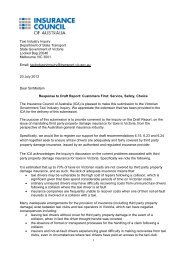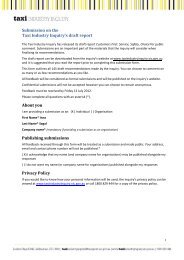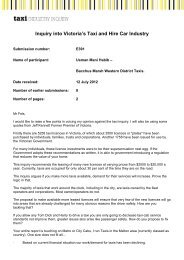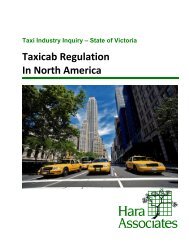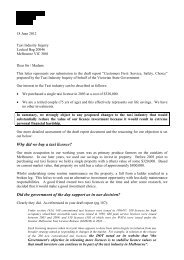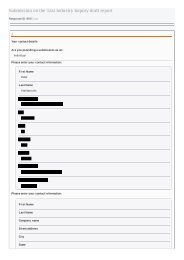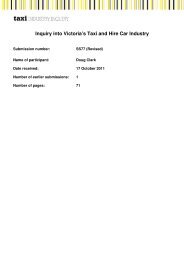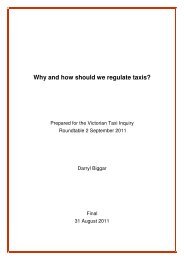Part D â Understanding and improving industry performance (PDF ...
Part D â Understanding and improving industry performance (PDF ...
Part D â Understanding and improving industry performance (PDF ...
You also want an ePaper? Increase the reach of your titles
YUMPU automatically turns print PDFs into web optimized ePapers that Google loves.
11.4.2. M<strong>and</strong>atory network affiliation<br />
There are no specifically stated regulatory objectives<br />
with regard to m<strong>and</strong>atory network affiliation. However,<br />
the general underst<strong>and</strong>ing within the <strong>industry</strong> <strong>and</strong> of the<br />
regulator is that the requirement exists to:<br />
• Facilitate universal access to taxis, enabling<br />
customers to access a taxi day or night through<br />
the NSP<br />
• Provide a safety communication system for drivers<br />
<strong>and</strong> passengers where vehicles can be tracked by a<br />
GPS link <strong>and</strong> an emergency warning system can be<br />
activated by the driver in case of an emergency.<br />
Licence conditions for Melbourne metropolitan taxis<br />
require the operator to ensure that the licensed vehicle<br />
is “at all times operated under radio control from an<br />
NSP for the receipt <strong>and</strong> dispatch of bookings for taxicabs,<br />
<strong>and</strong> that the vehicle is fitted with fully operational<br />
GPS system equipment linked to that NSP.” 35 While the<br />
wording of licence conditions varies, similar requirements<br />
for dispatch of bookings also apply to taxis outside the<br />
metropolitan area.<br />
In addition to these licence conditions, section 133 of<br />
the Transport (Compliance <strong>and</strong> Miscellaneous) Act 1983<br />
contains provisions that contend that network affiliation is<br />
a legislative requirement.<br />
An operator is only permitted to affiliate their vehicle with<br />
one accredited network. The rationale for this restriction<br />
is not known to the inquiry, but its presence is likely to<br />
reduce competition <strong>and</strong> hamper the efficiency of the<br />
fleet. In an efficient booked market, taxi operators could<br />
choose to align with two or more networks, seeing value<br />
in access to niche markets. In turn, this would provide an<br />
incentive for networks to seek out different or varied work<br />
<strong>and</strong> aid competition for network services.<br />
Previous reviews of the taxi <strong>industry</strong> in Victoria have also<br />
questioned the requirement for m<strong>and</strong>atory affiliation.<br />
The 1986 Foletta inquiry recommended that m<strong>and</strong>atory<br />
affiliation be removed to “encourage competition <strong>and</strong><br />
innovation <strong>and</strong> allow groups of licence holders to tailor<br />
operations to suit particular market segments.” 36<br />
KPMG expressed concern that, “the requirement that<br />
all taxi-cabs must be operated under radio control may<br />
prevent taxicabs from exclusively operating from another<br />
form of network (i.e. mobile phone or pager).” 37<br />
The Essential Services Commission, in its 2007/08 review<br />
of taxi fares made the following observation:<br />
The requirement that operators affiliate with a depot<br />
exposes them to costs which may escalate in an<br />
environment of imperfect competition. It has already<br />
been observed that among depots there is significant<br />
market concentration. Market consolidation reduces<br />
the degree of competition, thereby reducing the<br />
relative bargaining power of taxi operators <strong>and</strong><br />
drivers. This is further exacerbated by compulsory<br />
depot affiliation which m<strong>and</strong>ates that operators deal<br />
with a depot irrespective of what conditions are<br />
being offered. 38<br />
11.4.3. Secondary networks<br />
Secondary NSPs are also required to be accredited;<br />
however, their requirements under the scheme are minimal<br />
compared with those for primary NSPs. In order to be<br />
accredited, secondary networks must demonstrate that:<br />
• Relevant persons in relation to the organisation are<br />
of good character<br />
• They have business <strong>and</strong> financial capacity to effectively<br />
carry out their activities as a secondary network.<br />
Presumably because operators are required to be<br />
affiliated with a primary NSP, secondary networks are<br />
not required under the accreditation scheme to manage<br />
customer complaints, provide for the safety of drivers,<br />
have disciplinary procedures for drivers or have systems<br />
capable of recording information in relation to bookings<br />
<strong>and</strong> other data related to their operation.<br />
Even though secondary networks are not subject to the<br />
same level of regulation as primary NSPs the inquiry has<br />
found that customers have a considerably higher level of<br />
satisfaction with their service offering. 39<br />
The rationale for accreditation of secondary networks<br />
appears to be less clear than for other accredited parties.<br />
Secondary networks have no regulated obligations to<br />
provide any level of service to customers or to their<br />
members, making it difficult to see how accrediting these<br />
<strong>industry</strong> participants contributes to the stated purposes<br />
of accreditation: safety, efficiency <strong>and</strong> reliability.<br />
35 For example, Taxi-cab licence conditions for Conventional Fixed-<br />
Term Licences, Transport (Compliance <strong>and</strong> Miscellaneous) Act 1983,<br />
section 144<br />
36 Foletta, B (1986) Report of the Taxi Inquiry – Melbourne <strong>and</strong><br />
Metropolitan Area, p.57<br />
37 KPMG Consulting, (1999), Op. Cit., p.39<br />
38 Essential Services Commission (2008a), Taxi Fare Review 2007/08 –<br />
Interim Report, Melbourne, p.59<br />
39 Ipsos Social Research Institute (2012), Op. Cit., p.80<br />
<strong>Underst<strong>and</strong>ing</strong> <strong>industry</strong> <strong>performance</strong> CUSTOMERS FIRST 233





